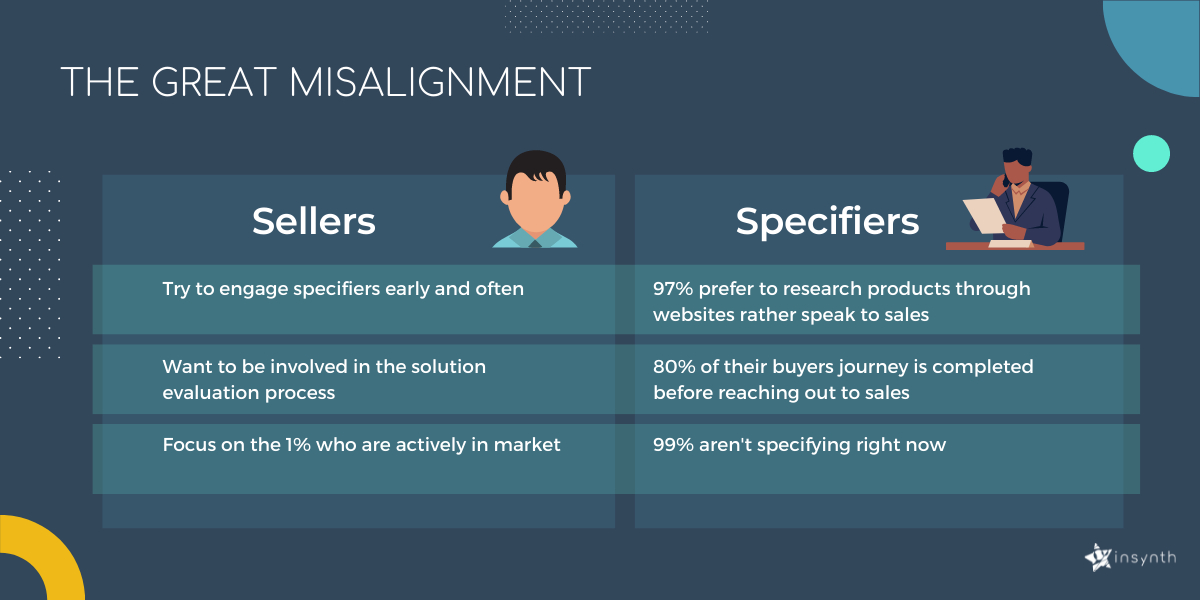
There is a huge need for specification marketers. But there are not many of them out there. And not many people understand what specification marketing is and how it’s different from traditional construction marketing.
The specification marketer’s goal is to generate enquiries from architects and designers.
Historically, building product companies have relied largely on sales teams or reputation to do this. But it's getting harder.
Salespeople have told us this over and over. Architects don’t want to speak to them. When they do, they don’t need them in the same way they used to. They have managed to find most of the information by themselves.
What sales teams need, is specification marketing teams. Marketing teams who understand an architect’s research process and connect with them early, so that architects don’t end up learning about various solutions from their competitors.
But specification marketers largely don’t exist.
Most building product marketing teams are doing traditional marketing.
Traditional marketing focuses on product promotion. Promotional marketing is costly and ineffective in the design environment. Specification marketing focuses on design insight that changes the way architects see their design challenges and your product. The insight leads back to the unique qualities of the product. The outcome is more specifications that are harder to break.
Let’s dig into this in more detail.
Why is this important?
In the past, building product companies have invested heavily in sales teams to make phone calls, visit practices, and provide CPD.
The best salespeople were not the most polished, but the most experienced. Reps who had a wealth of design insight that they could share with the architect, and become a trusted partner.
However, this isn’t working nearly as well as it used to.
These experienced, well-paid specification sales teams are now underperforming.
We’ve talked to hundreds of companies who confirm this.
We talked to one company where sales reps with 20 years of experience are being put on development plans even though they met their targets for the first 18 years.
So for the first 18 years they did well.
For the past 2 they did poorly.
What changed?
It wasn’t their skills or approach.
These experienced sellers didn’t become bad reps overnight.
What happened?
The Great Misalignment
What sellers want, and what modern specifiers want, are increasingly different.
- Sellers want to speak to specifiers early and often - specifiers prefer to learn online and only speak to sales when they need to.
- Sellers want to be part of the educational journey - specifiers seek out their own information and self-educate.
- Sellers focus on the 1% of buyers who are actively buying - most specifiers are not currently interested.

So specification sales is fundamentally misaligned with the way the modern specifier wants to specify.
They miss each other.
The only exception to this is CPD.
Traditionally, the sales team delivered CPD.
But CPD, like most things, is moving online. Construct UK reported, “91% of CPD attendees now choose an online format over an in-person presentation”. So this is increasingly falling into marketing’s remit too.
Where are the Specification Marketers?
So if sales is struggling to gain traction with specifiers, then it falls to marketing to step up to the challenge.
But a quick search on LinkedIn shows how many specification marketers are out there.
0
There are no “specification marketers”
The job does not exist.
Why?
Because the challenge of specification marketing is not understood.
Traditional Building Product Marketing
Traditionally, marketing teams put together brochures and technical documentation that were delivered to architectural practices and added to product libraries.
Today, architectural practices don’t have product libraries.
The average function of marketing in most building product companies consists of: updating the website, editorial in trade publications that won’t be read, emailing architects using bought data, and doing a bit of paid advertising on Google.
But this struggles to gain traction, incurs cost, and is ineffective.
They are random acts of marketing.
They don’t cohere to an overarching strategy.
And they are typically self-promotional.
“We have 40 years of experience”
“We have 10 locations”
“British-made”
“Sustainable”
“Fast lead times”
“Quality products”
These types of messages fail to cut through in an age where the average person sees 4,000 digital advertisements per day (Forbes).
Modern Building Product Marketing
The problem with the traditional marketing approach, is that it generally aims at reaching the 1% of the design community who are looking for their particular type of product at that point in time.
The goal is an immediate response. Direct enquiries. Leads.
But only 1% of the audience (or less) is even considering spec’ing a product, and you are using disruptive marketing tactics aimed at the entire 100% of the audience trying to find the needle in the haystack.
The bigger challenge here is to connect with that 100% in a way that impacts all of them. This way, when they are looking, they come to you. But how do you do this?
Create assets that focus on design insight.
Focus on helping your audience do their job better. Not on the transaction.
Help them identify a new way of approaching an old problem. Or a clever feature of a familiar product. Or raise awareness of issues that they may not understand.
Each of these approaches should lead back to the unique features of your product.
As you do this, you will generate demand for your product.
People will start ringing you up. Enquiries will come through the website. And the sales team will be busy servicing orders, instead of tracking them down.
Identifying Your Insight
The most difficult thing is identifying what your design insight is.
You need a topic that you are an expert in.
And one that also naturally leads back to a unique aspect of your product.
To get there, you may need to carry out audience research, interview your product people to discuss the features of your product, and then wrestle with a lot of bad ideas until you stumble upon the one good idea that falls in the overlapping area between specifiers’ interests, and your unique product benefits.
.png?width=1200&height=600&name=The%20Great%20Misaligment%20(1).png)
But once you have insight, build on it and spin it out every way you can.
Develop a media machine.
Don’t just create a CPD deck that sits in a dusty corner of your website.
Create regular content that is easily consumable and your audience will find. Things like:
- Articles on your website (websites are architects #1 source for product information according to CIM research)
- Guides
- Whitepapers
- Webinars
- Podcasts
And start publishing consistently.
The greatest challenge is identifying the insight. Then you can repackage and repurpose it on each of these channels and evolve it over time.
If you do this, you’ll start to see compounding results.
Why Does This Work?
Your specifier audience spends large amounts of their time passively learning. They are online, listening to podcasts, watching videos that interest them, and sharing things with friends and colleagues. If you are showing up in these spaces, and actively educating them, then they learn things that help them in their job. And they hear about you.
People have 1-2 products in mind for any given product category. If you show up consistently in this way, you position yourself to be one of those 1-2 brands. And if you have a unique point of view that corresponds with a unique product feature, the likely outcome is that you will be the only brand in mind.
As one of our prospects said, “we’re not going anywhere else”.
If you’ve been the one educating them, and have a point of differentiation, then you win the opportunity to be the trusted supplier.
And that’s modern specification marketing.
Conclusion
Specification sales needs help. They can’t have conversations if the door is shut (and bolted). It’s time for specification marketers to understand their role in opening the door - in generating demand for their product. To do this, they must show up with real design insight, not fluffy thought leadership. And then they need to do this consistently in the spaces where specifiers spend their time and learn new things.
If companies do this, the sales team will be busy, and the marketing team can play a much more significant role than they have historically. It’s time for construction marketing to understand the need of the moment, modernise their approach, and align themselves with their specifier audience.
If you have any questions email jack@insynth.co.uk.

